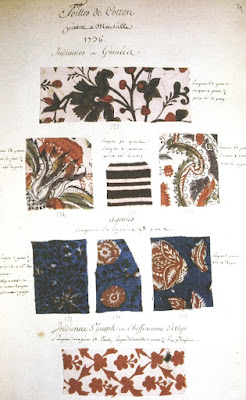Amy A's repro star could be described in many ways.
This week we'll consider the fashion terms
sprigged muslin and Indiennes.
Sprig muslin star on chintz
by Becky Brown
Whether your regency reading is textile history or Georgette Heyer's romances you've seen the words Sprig Muslin before.
Sprig or sprigged muslin refers to a fine white cotton, embroidered or woven with a pattern. The design was often white on white as in the ruff collar worn by Miss Lockhart Alexander, portrait by John Hoppner.
But a contrasting color on white was also popular.
Emma Corbett Making Childbed Linen
During A Voyage At Sea (detail)
There is much discussion in Jane Austen's Northanger Abbey about Catherine's "sprigged muslin robe with blue trimmings," perhaps resembling the dress in the 1794 illustration of the fictional Emma Corbett.
Ackermann's Repository
featured a swatch of block-printed
sprigged cotton in an 1813 issue.
Printing cotton was all about imitating more expensive fabrics so there was a large market for block-printed, sprigged muslin that imitated embroidered cotton.
Fine muslin with printed sprigs from the Copp
Collection at the Smithsonian Institution
We've discussed these cotton prints before in different categories. The technology is wood block printing; the set design is often a foulard/diagonal grid. But the style terms are sprigged muslin or Indiennes.
See woodblocks here:
Foulards here:
Ackermann's Repository showed "Muslin Patterns"
in 1815.
Muslin to us is an inferior weave, but in the early days of cotton clothing in the West, muslin referred to a fine, light weave. It was often a synonym for cotton.
This week we'll consider early prints in terms of style---No one in Jane Austen's novels ever mentions a block-printed, cotton foulard, but sprigged muslins come up frequently. Sprig refers to a simple, small floral---"a sprig of lavender." These prints initially were imported to the west from India, so another name refers to their origins: Indiennes
Swatches of Indiennes, "Toilles de Cotton" imported through
Marseilles, France
1736
The word Indiennes initially meant any printed cotton from India.
And then came to mean cotton printed elsewhere in imitation of Indian style.
Detail of a British quilt, 1820s
"... a small isolated figure set in diagonal repeat. Figures fall in a half-drop repeat with rows aligned in staggered fashion, giving the over-all effect of a diamond grid. The figure may be a flower, leaf, paisley cone, or motif so abstract it is identified only as a mignonette (little fancy). The print style with its diagonal, neat design is also known as an Indienne, a copy of an Indian-style print."
Reproductions
Chintzes and sprigs, reproduction hexagons
by Georgann Eglinski
Repro block by Becky Brown
A multicolored sprigged muslin as background.
The set style is a floral trail.
Sprig Muslin Star by Bettina Havig
Repro by Bettina Havig
A tossed set in a sprigged muslin as background.
A grid set as background by Bettina.
All these sets are variations of Indiennes and sprigged muslins.
The Indienne style is still an important category of fabric design today. Here are three new prints from Moda, coming out in November, 2015, that aren't being marketed as reproduction prints, but of course they are. These basic figures have been printed in thousands of subtle variations over the centuries.
What to Do With Your Stack of Stars?
Piece Them Into a Garden Maze.
Quilt from about 1830.
Stars set in a pieced sashing
we call Garden Maze.
Collection of the International Quilt Study Center and Museum
#1997.007.0540
Despite its complexity, the set is found in early quilts.
Johann Kimmel painted a quilt with a garden maze set in
his 1814 picture The Quilting Party.
There might be X patchwork blocks barely visible,
or the blocks could be unpieced...
like this mid-19th-century quilt from Ruth Finley's collection.
Quilt date-inscribed 1830.
A green calico star from the end of the 19th century.
Pook and Pook auction house sold this beautiful
mid-19th-century example in 2010.
I could tell you how to make a quilt much like this for 6" stars.
But Dawn Heese has already done it.
Her Pathways quilt with 25 six-inch stars finishes to 66" x 78"
The pattern is in her 2014 book
Autumn Splendor
One More Thing About Sprigged Muslin
"denying me a fmall fum to purchafe a piece of fprigged muflin"
Problems in a marriage 200 years ago---
related to fabric purchases.
"La, if you have not got your spotted muslin on!"
Jane Austen, Sense and Sensibility
Other names include
"Spotted Muslin"
And "Book Muslin"
Swatch number 4 (lower right) in this page from Ackermann's Repository in 1809 is captioned "Printed book muslin for evening wear," according to textile historian Florence Montgomery. She discussed muslin in Textiles in America, 1650-1870. Book muslin was another name for the same stuff, but referred to the way it was folded for sale---similar I guess to our words flat-fold today.
See a preview of Montgomery's book with a muslin discussion on page 304 by clicking here at Google Books:



































2 comments:
I first heard of sprigged muslin when studying Austen in college in 1978, many years before I Started quilting and become interested in quilt history and antique fabrics. Luckily our professor covered the material culture of Austen's time. We learned what a sprigged muslin was, and what color were puce gloves, and about the many kinds of carriages.
I re-read "America's Printed Fabrics 1770-1890" (amazing book) just yesterday and noted 'sprigged muslins' as a type I needed to separate from regular shirtings as I have with the conversationals! Once again, thanks for the delightful lesson!
Post a Comment